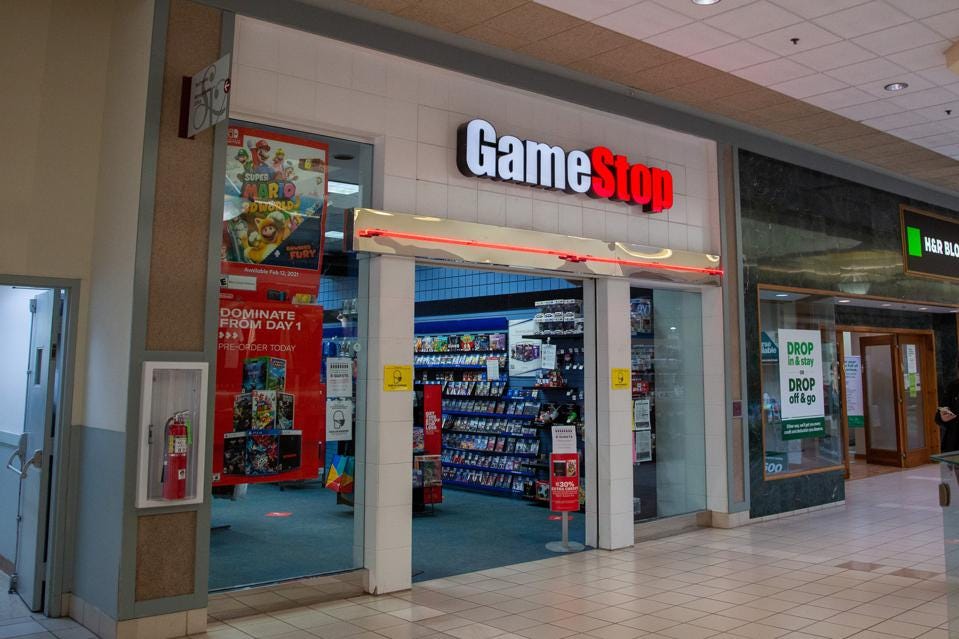Stock splits have repeatedly commanded headlines in the past two years. In 2020, the Apple stock split saw investors enjoy a 4-for-1 split, while Google executed a 20-for-1 split just this last Monday. Other major tech companies that have split recently following sky-high share appreciation include Amazon, Nvidia and Tesla.
This week, the $GameStop(GME)$ stock split will continue the trend when GameStop executes a 4-for-1 split on 21 July. But unlike the other names on this list, the beleaguered video game retailer isn’t splitting at the top of its game. So, for many following the company, the question remains: why?
What is a stock split?
Stock splits occur when companies divide their existing shares by a specified ratio to create new shares. In turn, the split lowers the price of individual shares while maintaining a company’s market cap (and the value of investors’ holdings).
For a quick example, say that Stock A is worth $1,000. If the company decided to execute a 10-for-1 stock split, each share would split into ten shares worth $100 apiece.
In theory, stock splits increase share count while leaving the company’s value intact. In reality, stock splits can temporarily increase price volatility following the announcement and in the days surrounding the actual split.
 Why do companies split their stock?
Why do companies split their stock?
One of the primary goals behind a stock split is to lower the price of a stock to make them more affordable. When shares rise into the upper hundreds or thousands of dollars, retail investors may be priced out.
We saw this happen with several major tech stocks during the pandemic. As tech demand soared, so did share prices, leaving many everyday investors unable to buy shares of companies like Apple, Alphabet and Nvidia.
By splitting shares when prices rise, these companies make individual shares more affordable for retail investors. At the same time, this increasesliquidity, as shares trade more freely when more investors can access them.
Companies may split stock for other reasons, too. For instance, if the firm sees more growth in its future, splitting shares allows that growth to show up in stock prices. The process also gives employees more flexibility in their employee stock-based compensation packages.
Lastly, some companies may consider stock splits if they hope to end up in a stock index likethe Dow, which may set admission requirements that include share prices.
Looking forward to the GME stock split
Apple and Google are far from the only stocks that have split since the pandemic began.Kellogg, Nvidia, Tesla and Amazon also make the list of big names that have divided their shares. And this week, GameStop plans to capitalize on the last two years of market turbulence with their own GME stock split.
GameStop’s recent performance
Unsurprisingly, GameStop’s share price has tumbled with the broader market in 2022. This year’s losses piled on top of the stock’s shocking 31% drop in 2021 after its ascension tomeme stock status.
But GME made a comeback in early July, gaining 15% in just days. A large portion of the gains can be accredited to investor enthusiasm about its upcoming stock split – the company’s first in 15 years.
The 4-for-1 division, first announced on 31 March and confirmed on 6 July, will occur after trading closes on 21 July. Investors who owned shares by market close on 18 July will receive three new shares for every share owned on that day.
Why is GME splitting?
For many investors, the GME stock split is a bit of a puzzle. At just under $147 per share at the time of writing, its price is a far cry from Apple’s price during its 2020 stock split. And it positively pales compared to Google’s $2,200 pre-split value.
It’s possible that GameStop is trying to return its share price closer to its “true”valuation, as the company’s P/E ratio has recently run into the negatives. But some analysts have criticized the move as a ploy to drum up investor interest and capitalize on current trends.
So far, the numbers seem to fit. For instance, in fiscal 2021, GameStop lost more than $400 million despite its historic meme stock status. And the company announced a new round of layoffs just days after revealing its stock split.
What do the Alphabet, Apple and GME stock splits mean for you?
Apple’s 4-for-1 stock split pales in comparison to Google’s massive 20-for-1 split. But even the Apple stock split looks hefty compared to GME’s stock split from $147 per share to around $37 per share.
Still, the stock splits won’t greatly impact either Google or GameStop’s market value – in theory, anyway. After all, the goal is a stock split is to increase the number of shares without affecting market cap.
But in practice, stock splits often lead to increased price volatility. While investors and day traders may view this as a chance to increase their gains, it’s also a time ripe for losses. (Especially for investors who don’t practice buy-and-hold investment.)
On a longer-term horizon, tech investors may also look forward to higher gains. Studies show that stocks that split see anaverage price appreciation of 25%in the year following the split, compared to a 9% gain in non-split stocks.
Unfortunately, when it comes to GameStop, it’s difficult to say how a stock split could impact investors’ prospects. While many stocks do see increased volatility and gains following a split, those stocks generally don’t split at comparatively low prices – or have a history of trading above their valuation based on meme status.
Comments